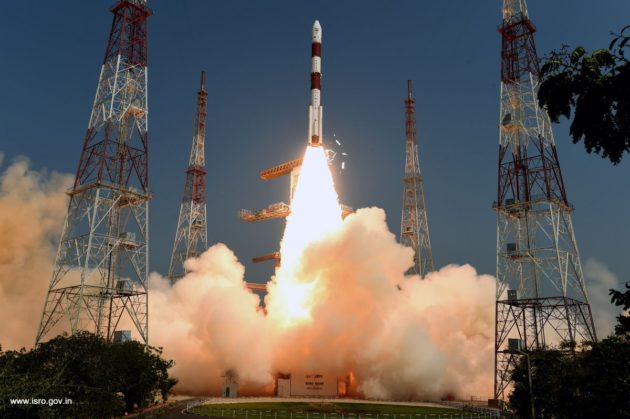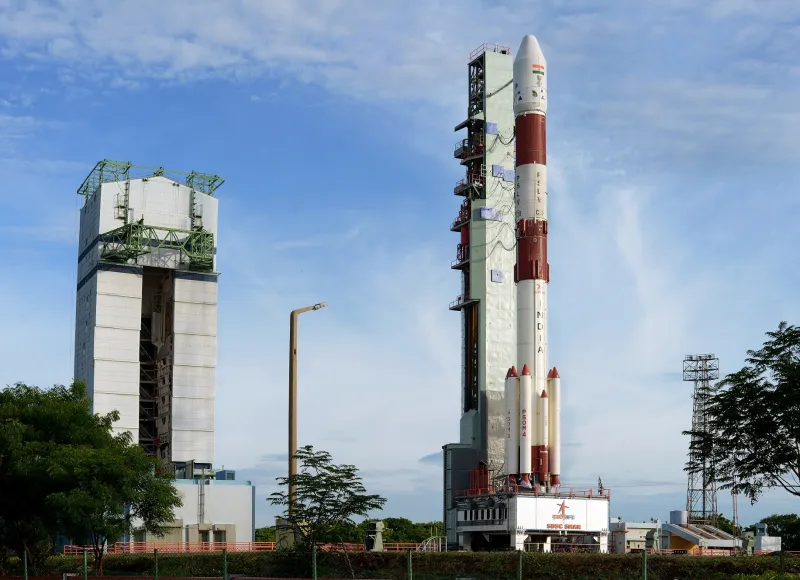Featured image credit: ISRO
Lift Off Time | February 14, 2022 – 00:29 UTC | 05:59 IST |
|---|---|
Mission Name | EOS-04 / Earth Observation Satellite – 04, flight C52 |
Launch Provider | Indian Space Research Organization (ISRO) |
Customer | ISRO |
Rocket | Polar Satellite Launch Vehicle (PSLV) |
Launch Location | First Launch Pad, Satish Dhawan Space Centre (SDSC), India |
Payload mass | 1,736 kg |
Where is the satellite going? | Sun-synchronous orbit (SSO), 529 km |
Will they be attempting to recover the first stage? | No, this is not a capability of PSLV |
Where will the first stage land? | It will crash into the Indian Ocean |
Will they be attempting to recover the fairings? | No, this is not a capability of PSLV |
Are these fairings new? | Yes |
How’s the weather looking? | N/A |
This will be the: | – 6th flight of the RISAT programme – 54th flight of a PSLV rocket – 23rd flight of a PSLV-XL configuration with 6 x PSOM-XLs – 80th launch from the Satish Dhawan Space Centre – 14th orbital launch attempt for 2022 |
Where to watch | Official livestream |
What Does All This Mean?
India is launching EOS-04, the fifth flight in its RISAT programme, along with two rideshare payloads. This programme provides a set of radar imaging Earth observation satellites, to a Sun-synchronous orbit atop a Polar Satellite Launch Vehicle (PSLV) rocket. The flight designation is C52. EOS-04 was previously designated RISAT-1A.
What Is EOS-04?
EOS-04 is a radar imaging Earth observation satellite, expected to operate until at least 2027. The primary instrument onboard is SAR-C. This stands for Synthetic Aperture Radar (in the so-called C band, with a frequency of 5.35 GHz). It is a high-resolution, all-weather, multi-purpose imager for ocean, land and ice.
| Operation mode | Resolution | Swath | Field of View | Polarisation |
| HRS (High Resolution Spotlight) | 1 m | 10 km | 659 km, either right or left | HH or VV or HH/HV or VV/VH |
| FRS-1 (Fine Resolution Stripmap-1) | 3 m | 30 km | 659 km, either right or left | HH or VV or HH/HV or VV/VH |
| FRS-2 (Fine Resolution Stripmap-2) | 9 m | 30 km | 659 km, either right or left | VV/HH, HH/HV, VV/VH |
| MRS (Medium Resolution ScanSAR) | 25 m | 120 km | 659 km, either right or left | HH or VV or HH/HV or VV/VH |
| CRS (Coarse Resolution ScanSAR) | 50 m | 240 km | 659 km, either right or left | HH or VV or HH/HV or VV/VH |

What Are The Rideshare Payloads?
INS-2TD
This is a technology demonstrator built by ISRO. It is a precursor to a follow-up joint mission between India and Bhutan, for the INS-2B joint satellite. Its payload is a thermal imaging camera, designed to help assess:
- land surface temperature
- water surface temperature of wetlands/lakes
- delineation of vegetation (what areas are crops? what are forests etc.?)
- thermal inertia (temperature variation between day and night)
INSPIREsat-1
This is a student satellite developed by the Indian Institute of Space Science & Technology (IIST). It has been built in association with the University of Colorado, USA. Additional contributions have been provided by Nanyang Technological University, Singapore, and National Central University, Taiwan. It has two scientific payloads on board to improve understanding of
- dynamics of the Earth’s ionosphere
- the Sun’s coronal heating process
Overall Headline Figures
| Satellite | Mass (kg) | Power (W) | Mission life |
| EOS-04 | 1,710 | 2,280 | 10 years |
| INS-2TD | 17.5 | 42 | 6 months |
| INSPIREsat-1 | 8.1 | 30 | 1 year |
What Is The PSLV?
India’s Polar Satellite Launch Vehicle comes in several variants. These are:
- PSLV-G
- PSLV-CA
- PSLV-DL
- PSLV-QL
- PSLV-XL
This flight is a PSLV-XL flight, meaning that it features 6 strap-on side boosters. With these strap-on boosters, the PSLV is a five stage rocket (four main stages plus boosters), using a variety of propellants.

Side boosters
The side boosters are ignited at launch time, once the core stage main motor is running. It has 6 × PSOM-XL / S-12.
Stage One (PS1)
The first stage is 20 m tall, and 2.8 m wide. It uses hydroxyl-terminated polybutadiene (HTPB) propellant, using an S139 solid rocket motor. This stage has a 110 second burn time, with the motor featuring an efficiency of 137 seconds ISP (at sea level). It has a maximum thrust of 4800 kN.
Stage Two (PS2)
The second stage is 12.8 m tall, and 2.8 m wide. It uses Unsymmetrical dimethylhydrazine (UDMH) as fuel and N2O4 as oxidiser. The Vikas engine on this stage was developed by the Liquid Propulsions Systems Centre. The motor runs for a burn time of 133 seconds, with the engine having an efficiency of 293 seconds ISP.

Stage Three (PS3)
The third stage is 3.6 m tall, and 2 m wide. It uses HTPB solid propellant, similar to the first stage, and features an S-7 engine. This stage runs for 83 seconds burn time, and the motor has an efficiency of 295 seconds ISP. Maximum thrust on this stage is 240 kN.
Stage Four (PS4)
The last stage is 3 m tall, and only 1.3 m wide. This is a liquid-fuelled stage, using monomethylhydrazine (MMH) for fuel and mixed oxides of nitrogen (MON) for oxidiser. The stage has two PS-4 engines, each of which produce 6.6 kN of thrust. The stage runs for 525 seconds of burn time, and has an efficiency of 308 seconds ISP.
Expected Flight Profile
| Event | Time (s) | Local Altitude (km) | Inertial Velocity (m/s) |
| RCT[2] Ignition | -3 | 0.024 | 451.9 |
| PS1 Ignition | 0 | 0.024 | 451.9 |
| PSOXM XL 1 & 2 Ignition | 0.42 | 0.024 | 451.9 |
| PSOXM XL 3 & 4 Ignition | 0.62 | 0.024 | 451.9 |
| PSOXM XL 5 & 6 Ignition (in flight) | 25.0 | 2.742 | 570.7 |
| PSOXM XL 1 & 2 Separation | 69.9 | 26.943 | 1,304.2 |
| PSOXM XL 3 & 4 Separation | 70.1 | 27.103 | 1,308.7 |
| PSOXM XL 5 & 6 Separation | 92.0 | 47.956 | 1,865.8 |
| PS1 Separation | 109.68 | 68.937 | 2,143.3 |
| PS2 Ignition | 109.88 | 69.174 | 2,142.4 [1] |
| Heat Shield Separation | 150.28 | 115.505 | 2,380.9 |
| CLG[2] Initiation | 155.28 | 121.099 | 2,407.9 |
| PS2 Separation | 262.46 | 237.047 | 4,033.4 |
| PS3 Ignition | 263.66 | 238.368 | 4,030.4 [1] |
| PS3 Separation | 493.60 | 450.692 | 5,815.1 |
| PS4 Ignition | 504.00 | 457.445 | 5,805.2 [1] |
| PS4 Cutoff | 1,020.36 | 533.967 | 7,592.0 |
| EOS-04 Deployment | 1,057.36 | 534.707 | 7,596.0 |
| INSPIREsat-1 deployment | 1,112.36 | 535.859 | 7,595.5 |
| INS-2TD deployment | 1,127.36 | 536.182 | 7,595.4 |
| MON[2] passivation start | 1,370.36 | 541.573 | 7,591.8 [1] |
| MMH[2] passivation start | 2,010.36 | 538.276 | 7,596.2 |
| CLG | Closed Loop Guidance |
| MMH | MonoMethylHydrazine |
| MON | Mixed Oxides of Nitrogen |
| RCT | Roll Control Thruster |




